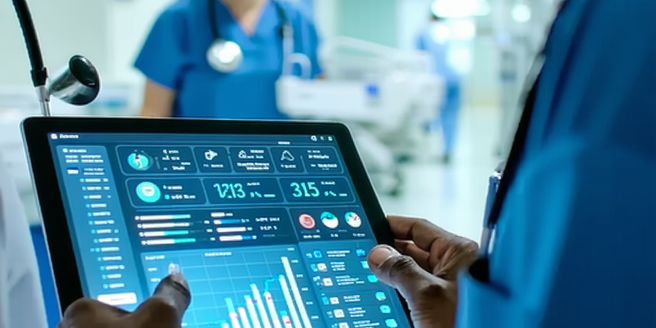
Cybersecurity Threats In Digital Health Systems
Digital health systems, including Electronic Health Records (EHRs), telemedicine, and mobile apps, are transforming patient care by facilitating seamless data exchange and providing crucial health insights. However, they also pose significant security challenges. Protecting patient data from breaches is vital to avoid severe consequences. Common cyber threats in healthcare include ransomware, phishing, and vulnerabilities in outdated systems. Robust cybersecurity measures, such as employee training and strong access controls, are essential to safeguarding data. Data breaches can compromise patient privacy, leading to identity theft and loss of trust. Emerging technologies like IoT, AI, and blockchain offer benefits but also introduce new security challenges. A comprehensive approach to strengthening cyber defenses involves regular audits, multilayered security, and fostering a culture of security awareness. As digital health systems advance, continuous investment in cybersecurity infrastructure is critical to maintaining trust and ensuring data protection in healthcare operations.

Popular Brands In Noise-canceling Headphones
Noise-canceling technology improves the listening experience by using built-in microphones and advanced circuitry to create anti-noise signals, effectively blocking ambient sound. This technology is critical for providing distraction-free music and podcast listening environments. Two primary types of noise-cancelation exist: active, which generates opposing sound waves, and passive, which uses physical barriers like padded ear cups. With remote work on the rise, noise-canceling headphones are increasingly essential. When selecting these headphones, consider features like battery life, comfort, design, sound quality, connectivity, and additional functions such as ambient sound modes and built-in voice assistants. Leading brands in this market include Sony, Bose, and Sennheiser, each known for their innovation and commitment to sound quality. Sony excels with adaptive sound control, AI noise-canceling, and battery life innovations. Bose is renowned for Acoustic Noise Canceling technology, offering life-like sound and adjustable noise levels. Sennheiser stands out for premium audio quality and features like Audio-Transparent mode, which balances immersive sound with environmental awareness.

Ai-powered Tools For Collaboration
The integration of AI in collaborative workspaces is revolutionizing team dynamics by enhancing communication, streamlining project management, and facilitating virtual collaboration. AI technologies automate routine tasks, analyze data, and improve decision-making, allowing teams to focus on creativity and innovation. AI tools enhance communication by breaking language barriers, offering intelligent chatbots, and providing insights into team dynamics. In project management, AI optimizes resource utilization and predicts potential delays, ensuring projects are delivered on time. For virtual teams, AI-driven solutions enable seamless interaction and meeting management. As AI progresses, future trends aim toward more personalized, intuitive, and integrated collaborative platforms, promising greater efficiencies and breakthroughs in team productivity.

Innovative Features In Collaboration Software
Real-time editing and co-authoring tools enhance collaboration by allowing multiple users to simultaneously edit documents, thus increasing efficiency and fostering teamwork. These tools support creativity, allow version tracking, and reduce errors. Integrated communication platforms streamline team interactions by centralizing messaging, video calls, and email, eliminating tool-switching and ensuring cohesive communication. AI-powered task management solutions optimize project execution by predicting deadlines, prioritizing tasks, and automating scheduling, thus improving productivity. Customizable user roles and permissions enhance security and efficiency by controlling access to content, preventing unauthorized access, and allowing for flexible role adjustments. Cloud-based document storage and sharing offer instant access to files, support real-time collaboration, and provide scalable solutions for growing storage needs, thereby promoting a flexible and seamless workflow.

Trends In Digital Communication Tools
Messaging apps have evolved from basic text-based services to multifunctional platforms offering voice, video, and multimedia sharing, driven by smartphone adoption and the demand for instant communication. Leading apps like WhatsApp and WeChat now offer end-to-end encryption and cater to personal and business needs. Video conferencing has become crucial for remote work, with tools like Zoom and Microsoft Teams offering features that mimic face-to-face interactions and potentially integrating virtual reality for more immersive experiences. Collaborative platforms like Slack and Trello centralize communication and project management, enhancing remote work efficiency. AI in digital communication enhances user experience through chatbots and predictive text, offering insights and personalization. Cloud technology supports scalable and accessible communication solutions, enabling data storage and access from anywhere with robust security measures. However, as these tools become more sophisticated, security challenges such as data breaches require vigilant protection and awareness from users and providers.

Privacy Enhancements In Devices
Understanding device privacy begins with grasping data protection fundamentals and staying informed about security threats and technological advancements. Key elements include hardware-level encryption, secure boot mechanisms, and trusted platform modules, complemented by regular software updates and multi-factor authentication. Emerging technologies like homomorphic encryption and differential privacy are advancing data protection. Firmware plays a critical role in device security, with secure boot processes ensuring its integrity. User-friendly privacy settings empower users to manage data permissions easily, while the balance between privacy and usability remains a challenge for developers. Future trends in device privacy involve biometric authentication, blockchain for decentralized storage, advancements in quantum computing, and edge computing to enhance data privacy.

Dashcam Safety Features
Modern dashcams are equipped with enhanced video recording technology that ensures clear high-definition footage in all lighting conditions, vital for incident evidence and enhancing road safety. They feature automatic incident detection, utilizing sensors to record and save critical moments during accidents, aiding drivers, insurers, and law enforcement. Night vision capabilities enable clear recording during nighttime, bolstering nighttime driving security. Real-time GPS tracking offers location and speed data, benefiting theft recovery and fleet management, while secure data storage options protect sensitive recordings through encrypted and cloud solutions. Additionally, driver assistance integration aids in safer journeys by alerting drivers to potential dangers. These cutting-edge features make modern dashcams an essential tool for road safety and accountability.

Headgear Insulation Techniques
Understanding the science of insulation is crucial for choosing effective headgear to maintain warmth. Insulation works by reducing heat transfer through conductive, convective, and radiative processes. The R-value measures insulation efficiency, with higher values indicating better performance. Common materials include wool, which retains warmth when wet, and synthetics like fleece and Thinsulate, known for lightweight insulation. Modern methods surpass traditional ones by offering lightweight, moisture-managing options. DIY headgear can offer customized insulation using various layering techniques. Evaluating thermal performance involves thermal imaging, user feedback, and R-value testing. Future trends focus on sustainable materials, biomimicry, and smart textiles for enhanced thermal regulation.

Smart Hubs For Device Connectivity
Smart hubs are central components in home automation systems, enabling communication and integration between various smart devices such as lighting, thermostats, security cameras, and door locks. By supporting protocols like Zigbee, Z-Wave, and Wi-Fi, smart hubs facilitate seamless interaction among diverse gadgets, allowing for streamlined control through a single interface or app. They play a vital role in ensuring device compatibility, enhancing convenience, and improving energy efficiency by automating routines and managing energy consumption. With the ability to sync with voice assistants, smart hubs offer hands-free operations and adaptability to occupants’ preferences. As the smart home market expands, understanding smart hub capabilities is crucial for maximizing household connectivity.

Smart Home Ecosystem Integration
Understanding smart home ecosystems involves exploring the interconnected devices and systems designed to improve convenience, security, and efficiency in homes. These ecosystems typically feature smart devices like lighting, thermostats, security cameras, and voice assistants, all integrated through a centralized hub. Key benefits of integrating smart home devices include centralized control, enhanced security, energy efficiency, and improved accessibility. Popular technologies in this space include smart speakers, lighting systems, thermostats, and security cameras. However, challenges such as device compatibility, network reliability, and privacy concerns exist. To overcome these, it is essential to choose compatible devices, maintain a robust Wi-Fi network, and stay informed about your system's capabilities. The future of smart home ecosystems promises further integration and innovation with advancements in artificial intelligence.

High-resolution Laptops For Design Precision
High-resolution displays are crucial in design, offering clarity and detail necessary for precision, color matching, and editing. They minimize pixelation and eye strain, aiding designers in spotting mistakes early and improving workflow. Top laptops for graphic designers include Apple’s MacBook Pro, Dell XPS 15, and Microsoft’s Surface Laptop Studio, known for their high-resolution screens and powerful performance. When selecting a design laptop, prioritize a high-resolution display, powerful processor, ample RAM, and good battery life. Balancing performance and portability is essential, with a focus on efficient processors and lightweight designs. The right screen size and resolution are vital, with 4K displays recommended for clarity and color accuracy. Integration of design software, such as Adobe Creative Cloud, enhances workflow efficiency, making these considerations crucial for professional graphic design work.

Desktop Enhancement Tools For Remote Productivity
Optimize your remote work setup with must-have tools and techniques for efficiency and productivity. Invest in ergonomic furniture and accessories such as a comfortable chair, premium desk, monitor stands, and proper lighting to create an ideal workspace. Organize your area with cable management solutions and ensure a reliable Wi-Fi connection. Leverage smart devices for added convenience. Enhance collaboration with top software solutions like Slack, Microsoft Teams, Trello, and Google Workspace for seamless communication and task management. Boost focus by using apps designed for concentration, the Pomodoro Technique, and browser extensions to block distractions. Cultivate routines and set clear boundaries to maintain work-life balance. Prioritize ergonomic accessories for comfort and invest in customization and automation tools like IFTTT or Zapier to streamline tasks. By implementing these strategies, you can create a distraction-free, productive home office environment where efficiency and comfort thrive.